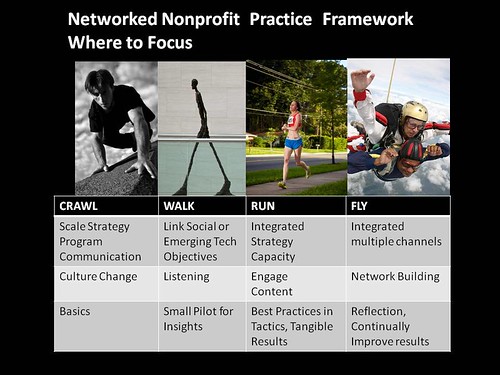
In our book, Networked Nonprofit, we describe the principles for becoming a networked nonprofit – a nonprofit that is simple, agile, transparent, and works more like a network than an isolated fortress. Networked nonprofits are experts at using new media (social media, mobile, and other emerging technologies) to spread their missions, design and scale programs, communicate with stakeholders, or inspire behavior change. Their impact is to make the world a better place.
Yesterday, during a webinar for GuideStar, the question was how does our organization put these high level concepts into practice? How does your organization avoid falling into the trap that a networked nonprofit is just about using tools and platforms? Your organization needs to think holistically. If you don’t have a developmental model, you won’t know where to start or how to prioritize your time. Or as Inga Broerman, Guide Star VP of Marketing said, “You won’t know what to say no to.”
I’ve been experimenting with a practice model that I’ve been using over the years and was able to crystallize some of my thinking into “Crawl, Walk, Run, Fly” that I’ve been testing for designing training workshops and peer learning projects. It is a self-assessment that a nonprofit could use to determine the level of their current social media practice and think about getting to the next step or a tool that a coach or trainer could use. The title was inspired by a quote from Martin Luther King, Jr:
“If you can’t fly then run, if you can’t run then walk, if you can’t walk then crawl, but whatever you do you have to keep moving forward.”
The Networked Nonprofit Practice Model
Putting the Networked Nonprofit ideas into practice and using social media and other emerging technologies will only be success if nonprofits take small, incremental and strategic steps. In this model, there are four different levels of social media practice: Crawl, Walk, Run, Fly. One level is not better than another; it is just where the organization is at with respect to becoming a networked nonprofit and agile at using social media and other emerging technologies.
It is important to note that it takes months, if not years, to reach the highest level of networked nonprofit practice. Not every nonprofit will go through the levels at the same pace due to organizational culture, capacity, or communication objectives, program design and target audiences.
Crawl
The nonprofit is not using social media or emerging technology or is not using it consistently. The organization lacks a robust communications strategy or program plan that can be scaled using a networked approach. “Crawlers” are not just smaller nonprofits, but may include larger institutions that have all the basics in place, but lack a social culture or is highly resistant to change from a command and control style to a more networked mindset.
These nonprofits need to see inspiring stories of similar size and type of nonprofits and from adjacent practices. For some, the first action step is to develop a basic communications strategy or program plan. Once in place, the first social media step should be listening and enhancing the web presence.
Some crawlers may already have a robust program plan or communications strategy in place, but are facing adoption challenges to working in a networked way. The first step is a discussion encouraged by leadership about the issues, followed by codifying the rules in a social media policy. The nonprofit must set up a robust listening process, integrating listening on social channels as part of program or communications planning research.
Walk
The nonprofit is using one or more social media tools consistently, but it is not strategic because it isn’t linked to a communications strategy, campaign, or program plan. Also, best practices on tools and techniques are part of the organizational skill set. These organizations may need assistance developing a social media strategy to support short and long-term SMART objectives and to carefully identify the audience.
Walkers have internalized listening and are able to use the data they collect to improve engagement and content best practices. The nonprofit also needs to focus on one or two social media tools, going deep on tactics, and seeing tangible results. Avoid spreading the organization’s resources too thin.
In addition, leadership may not fully understand social media and networked ways of working. Often, a “Return on Investment” argument surfaces. The organization must implement a small, low-risk pilots that can collect stories and numbers to help leadership better understand the value and benefit and costs.
The organization identifies low cost ways to build capacity internally – from using interns or volunteers effectively and integrating social media tasks into an existing job description. Staff members evaluate current job tasks and identify what they don’t need to do in order to make time for social media and other emerging technologies, all with support from leadership. They also must look to people outside their organization who they have connected with on social networks and enlist their help.
The nonprofit’s social media policy formalizes the value and vision for social media use and networked approach and encourages “outsiders” or free agents to help with implementation. The organization integrates simple measurement techniques and learning as an organizational habit that helps improve practice and documents results from the beginning of every networked approach.
Run
The nonprofit uses one or more social media tools and is strategic, but the problem is scaling. Building internal capacity may mature to a point of needing a half or full time staff person who serves as a community manager, building relationships with people on social media or new technology platforms. he networked approaches or social media is not in a silo or guarded by one person or department. This person also works internally as a network weaver or trainer to help other departments or individuals on staff incorporate the use of social media to support the organization’s programs. T This board is also using social media as part of its governance role.
The nonprofit effectively integrates social and emerging technologies such as mobile across all communications channels. The organization has strong capacity in content creation as well as repurposing or remixing across channels. The organization has also developed deep relationships so its crowd is inspired to create and spread content.
For program strategy, the organization uses techniques like crowdsourcing to get feedback on program design – whether it is help design a pilot, feedback on an evaluation, or rethinking of a program. The organization has adequately engaged and built relationships with key influencers whether organizations or individuals. The organization has codified and shared its program work flow and has made all program tools and materials available so its network can assist with implementation.
Organizations in this category also need to focus on using more sophisticated measurement techniques , tools, and processes. This may include benchmarking, shared organizational dashboards, and linking results to job performances for larger institutions.
Fly
The nonprofit has mastered everything at the running stage and internalized it. The organization has created a culture of public learning for both individuals and the entire organization. The organization uses data to make decisions, but leaders understand how to lead from the heart as well as the head. The organization has documented and shared dramatic results with its stakeholders and peer organizations. The organization is part of a vibrant network of people and organizations all focused on a social change outcome that makes the world a better place.
Also, as with all frameworks, the reality is messy. It might hard to for an organization to fit the profile in anyone category. It is simply a method to for a trainer to assess or nonprofit to self-assess their level of practice and figure out how to the next stage.
Where is your organization in this framework? What does that look like? What do you need to know, do, or have for success?

Leave a Reply